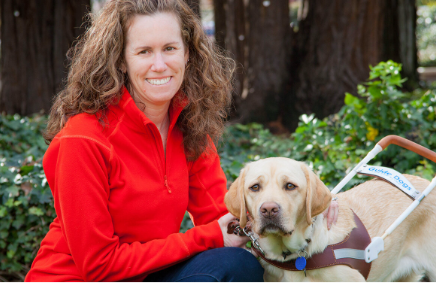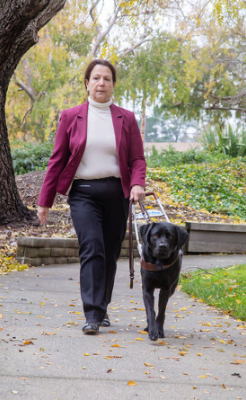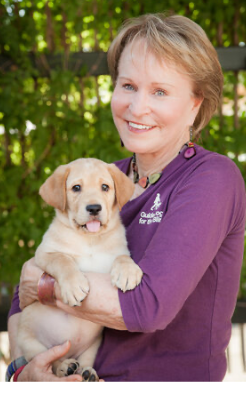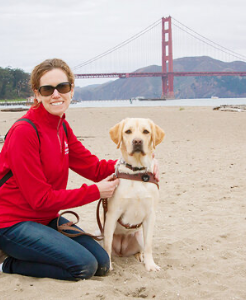Art reflects life in Disney’s Pick of the Litter
June 3, 2020
Puppies go prime time on Disney+ in a docuseries that follows a bouncy litter of pups hoping to one day become guide dogs for the blind.

Jane Flower with Pilaf, her third guide dog.
The picture fades up from black to reveal six rambunctious, wiggly puppies who immediately steal your heart. Stay out of their way, however, because Pacino, Tulane, Paco, Amara, Raffi and Tartan all have important work to do. The tail-wagging co-stars of Pick of the Litter, a Disney+ docuseries, are in training to become guide dogs—if they can make the cut. The series, based on a 2018 documentary of the same name, details the arduous journey of pups training to become guide dogs for the blind, from birth to graduation.
“Only the best of the best of the best become guide dogs,” Chris Benninger, President and CEO of Guide Dogs for the Blind (GDB), based in San Rafael, California, says. “It’s the most complicated of all types of service work because a guide dog has to make independent decisions for their person.” To help the world fully understand the difficulty of that work, Pick of the Litter gives us the dog’s eye view of what goes into the making of a great guide dog. That training, say guide dog recipients, can change a life.
A guide dog, a cocktail party, and a new independence
Janni Lehrer-Stein, diagnosed at 26 with retinitis pigmentosa due to mutations on the KIZ gene, describes herself as a partially functioning blind person, with no functioning vision or acuity. “A guide dog has changed my life exponentially in so many different and positive directions,” Lehrer-Stein says. “I am completely independent in terms of my mobility because of my partnership with Shiloh.”
The retired lawyer and disability advocate started using a cane in her mid-40s and got a service dog when she still had some vision remaining. When Lehrer-Stein lost her remaining vision, however, she finally applied for and received a guide dog. That, she said, is when her world opened up.
Like all guide dogs, Shiloh received training specific to his new owner’s needs. Lehrer-Stein served two terms on the National Council on Disability under President Barack Obama and as Senior Disability Advisor to the Hillary for America 2016 campaign. She also consults with and helps formulate disability policy for national and state campaigns and is on the Rules Committee for the Democratic National Convention. In other words, she needed a dog with good manners and an ability to navigate cocktail parties, airports, and big political gatherings.
“One of the things we did while training at GDB was to set up a cocktail party,” Lehrer-Stein says. “Staff, other students and some of the volunteers were all invited to an event that we held in a beautiful courtyard.” Janni and Shiloh practiced moving from one group of attendees to another. People dropped things and walked in front of Shiloh, but he stayed the course. And then, the big test. A pretend waiter dropped a very real tray of appetizers right next to the guide dog. He didn’t budge. Good boy, Shiloh.

Janni and her guide dog, Shiloh, walk the grounds of Guide Dogs for the Blind.
The making of a guide dog
Potential guide dogs start their training before they’ve even opened their eyes or can hear. “Most people don’t understand that what goes into a guide dog is literally 18 months of training, starting when they’re three days of age,” Benninger says. That, she says, is when the cuddlers step in.

Chris Benninger, CEO and President of Guide Dogs for the Blind, smiles with one of the organization’s newest members.
Cuddlers are volunteers who sit with the dog mom and her litter and cuddle the newborn pups. They hold and pet the pups. They touch their paws, their heads, and their tails. The goal is to get the puppies very comfortable with humans. “So, there’s no fear ever around a human,” Benninger says, “and we’re starting early with touching them so that they don’t develop body sensitivity, because they’re going to have to wear a harness.” Cuddlers, however, are just the first stop on the way to successfully becoming a “pick of the litter.”
Puppies stay on the GDB campus until they are 8 to ten weeks old. During that time canine welfare staff introduce the dogs to other people and begin to socialize them. This is an important period in a puppy’s life. Up until they’re about 12 weeks old, they have no fear. It’s key to expose them to all kinds of sights, sounds, textures, and experiences so that they aren’t phased by things when the life of their human is at stake.
The next stop in the life of a would-be guide dog is at the home of the puppy raiser. Each puppy is placed with one of the 2,000 puppy raisers throughout 10 western states. “They stay with their puppy raisers for the next year and there’s a very prescribed way of raising our dogs,” Benninger says. The organization demonstrates how to use positive reinforcement to train the dogs and the raisers use the method to teach the puppies good house manners and to walk on a leash. Raisers also expose the pups to as many different experiences as possible including going to the grocery store, visiting friends, and riding various forms of transportation.
When the dogs are somewhere between 14 and 16 months old, they return to GDB and go through 12 weeks of guide training with a professional instructor. During this time the dogs are assessed, and trainers determine who will make the cut to become a guide dog. “Our trainers say they can pretty much tell as they are going through the training process whether or not this is the profession that the dog wants,” Benninger says.
For example, if a dog isn’t excited to get into a harness, it’s a sign. “That doesn’t mean it’s not a great dog, but not all of us want the same job,” Benninger says, adding that many dogs who aren’t cut out as guides become “career change” dogs and go on to have illustrious careers in another kind of service—wheelchair assist, post-traumatic stress disorder (PTSD), autism support, and seizure or diabetic alert.

Jane, with Pilaf.
Guide dog aficionado
Jane Flower, the Youth Outreach Specialist at GDB, was born legally blind and diagnosed with Leber congenital amaurosis (LCA). In 2017, genetic testing finally uncovered one of the mutations responsible for her vision loss, an anomaly on the TULP1 gene. The information revealed that her IRD was probably a juvenile form of retinitis pigmentosa. Flower says she pursued genetic testing because she was envious of people introducing themselves—and their own genetic mutation—at conferences. “I was like, ‘Okay. I want to know. I want to know what’s going on for me,” Flower says.
Flower not only works at GDB but is now partnered with her third guide dog, Pilaf. When her second dog, Anja, retired from guiding, she became the family’s pet. Flower says Anja’s commitment to the work was incredible, a trait shared by all guide dogs who make the cut. “Even now, when I get the harness out for a walk, she comes running over. The other day she almost tried to put her head in it!” Flowers laughs. “She hasn’t been in that harness in two and a half years.”
To make the cut and end up working as a guide dog for the blind, these remarkable dogs will have worked with about 50 different people over the course of two years. They will lead with confidence but never try to dominate.
Like Lehrer-Stein, Flower travels a lot for work. The beauty of guide dogs, she says, is that they really free her up to move through space with less stress and more confidence. “I remember walking through the airport one day with a coworker who also had her guide dog. We were just walking and talking like everybody else does and our dogs were doing the work,” she smiles. “I mean, yeah, you have to pay attention but there was so much freedom in that.”
To make the cut and end up working as a guide dog for the blind, these remarkable dogs will have worked with about 50 different people over the course of two years. They will lead with confidence but never try to dominate. They will open doors and hearts on behalf of their person. And they will obey commands—unless they know better.
Benninger says that a dog who knows when it’s appropriate to say “no” to the boss is essential and recalls an incident that happened to one of GDB’s clients. That guide dog recipient works in a high-rise building in downtown Manhattan. Each day she takes the same bank of elevators to her office. Her guide dog knows which set of elevators she needs and always takes her to the right one. One particular morning, however, her guide dog said “no.”
“Her dog took her, instead, to the couches in the lobby,” Benninger says. “When she got to the couches, she was feeling just a little woozy and she sat down. That’s when she had a stroke.” Benninger believes that the bond between guide dog and owner is so strong that the dog can sense and maybe even smell when something isn’t quite right. The woman called GDB about six months after recovering from her stroke to share her story, and her thanks.
Given the dramatic difference a guide dog can make in the life of its owner, it’s not surprising that Disney+ scooped up the chance to follow a litter from birth to final training. Lucky for us, we can tag along on that journey in six 30-minute episodes. You’ll meet the pups, laugh and cry with their raisers, and applaud the proud dogs and their owners when the pairs graduate from the GDB program. Most of all, you’ll marvel at the way a life can change with the help of these amazing canine crusaders.
Sign up to find out when we add new stories to the site.
